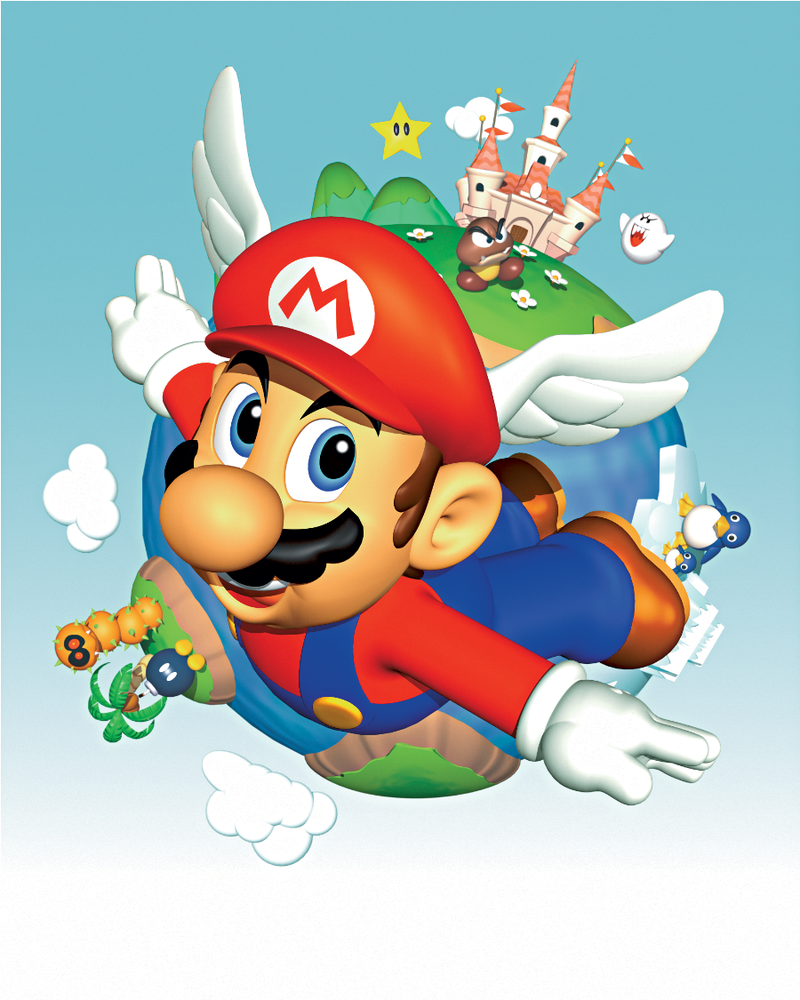 |
| On a wing and a plumber... |
“It's-a me, Mario! Hello!”
- take a wild guess
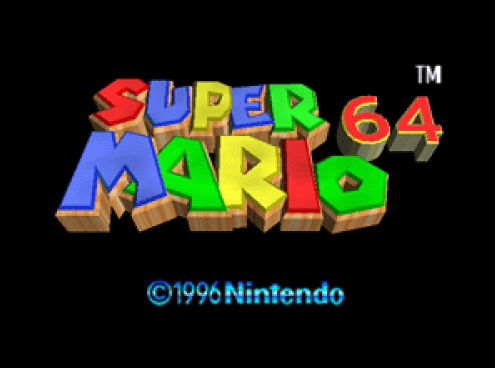 |
| What's that, Sony? Your PlayStation is a 32-bit system? That's cute. Guess how many bits we've got! |
The Facts
Release Date: June 23, 1996 (Japan) September 29, 1996 (North America)
Original Platform: Nintendo 64
Director: Shigeru Miyamoto (general director) Yoshiaki Koizumi, Takashi Tezuka (assistant directors)
Producer: Shigeru Miyamoto
Also Playable On: Nintendo 64DD (tech demo), iQue Player, Nintendo DS (remake), Virtual Console (Wii, Wii U), Nintendo Switch, Nintendo Switch Online
What's the Deal
Princess “Peach” Toadstool has invited Mario over for some cake. Mario takes a Warp Pipe to the Mushroom Castle, and is greeted by a Fishin' Lakitu carrying a film camera, who says that he and his brother will be filming and reporting on Mario's adventure.
Mario then enters the castle, only to find that it's empty and most of the doors are locked. He talks to a Toad, who reveals that Bowser has invaded the castle, captured Princess Toadstool (again), and imprisoned everyone inside the walls of the castle, through the magic of the Power Stars.
Mario's mission: to explore the worlds inside the castle walls, retrieve the stolen Power Stars from Bowser's minions, and rescue the princess!
Background/Development
Bear with me here, there's a lot.
In the early 90s, Nintendo of America held an audition for the voice of Mario. The last person to record was an actor, mid-30s, named Charles Martinet, who had crashed the audition.
He was informed that he'd be voicing an Italian plumber from Brooklyn for a video game. Martinet was mostly unfamiliar with gaming in general, and while his first thought was to do a gruff voice (a la Captain Lou Albano or Walker Boone in the DiC cartoons), but realized that it might be off-putting to the kids playing the game, and just started improvising and rambling in a high-pitched, Italian-accented voice until the tape ran out.
Martinet has stated that his audition was the only one that Nintendo brought back to Japan, winning him the role of Mario.
Around this same time, Nintendo teamed up with SimGraphics to create an interactive system to use to promote products. The system, named “Mario in Real Time” (or MIRT) enabled people at video game trade shows to engage with a 3D model of Mario's head, as Martinet would watch a video feed of the show floor while wearing a motion-capture headset in front of a microphone, so attendees could, well, interact with Mario, in real time.
MIRT was Charles Martinet's first performance as Mario (as well as Wario and even Donkey Kong by '94), with his second allegedly being Gottlieb's 1992 Super Mario Bros. pinball table, though he claims that Gottlieb technically stole the voice clips and didn't pay him for it.
Miyamoto has claimed that the MIRT model (later seen in the Mario Teaches Typing PC games) was originally developed for a canceled 3D sequel to the SNES art program, Mario Paint, but I'm not sure if that's completely true, since the MIRT system was already in use when the first Mario Paint was released.
Miyamoto was reportedly inspired by Star Fox on SNES to do a 3D Super Mario game.
In 1993, Nintendo partnered up with Silicon Graphics, Inc., to begin development on their next home console, codenamed “Project Reality”, and later the “Ultra 64” in reference to the console's 64-bit CPU.
MOTHER/EarthBound series developer Shigesato Itoi proposed the final name of “Nintendo 64”.
Early tests involved a yellow rabbit, as well as Mario running around and performing basic actions on a blank grid.
In September 1994, development on the first 3D Super Mario game begins, under the title of Ultra 64 Mario Brothers.
As the title implies, the game was going to originally include both Mario and Luigi as playable characters via split-screen. The N64 console coming packaged with only one controller as well as hardware memory issues meant that Luigi was completely removed from the game, and the arcade Mario Bros.-style minigame had to be scrapped as well.
As the title implies, the game was going to originally include both Mario and Luigi as playable characters via split-screen. The N64 console coming packaged with only one controller as well as hardware memory issues meant that Luigi was completely removed from the game, and the arcade Mario Bros.-style minigame had to be scrapped as well.
Sorry, bro. Just wait, though! In five years you're gonna get your very own game where you're in the starring role!
The console (and Super Mario 64, by extension) was originally set for a Holiday 1995 release, but was delayed to Summer 1996 for Japan and Fall '96 for North America.
About half of the developers' time was spent refining the game system itself, with most level design occurring near the end.
The majority of the time was spent refining Mario's movements as well as the camera system, the latter of which underwent thousands of iterations.
Giles Goddard, an English programmer, was one of the first Western developers to work at Nintendo of Japan, and was part of the 15-or-so person team. He mainly was the one who developed the MIRT-inspired title screen and programmed the face-stretching Easter Egg.
The infamous N64 controller wasn't designed around Super Mario 64, but SM64 was the main way of testing it out, with Miyamoto reportedly not being a fan of the yellow C-Buttons to control the camera, and thinking that perhaps a second D-pad would've been better.
For the first six months, the team didn't even have a Nintendo 64 controller, but used modified SEGA controllers.
Co-director Yoshiaki Koizumi stated that every object having a shadow directly underneath it, regardless of lighting, “might not be realistic, but it's much easier to play”, due to it helping with depth perception, an “iron-clad necessity” for a 3D platform game.
Princess Peach's Castle had a very different interior design early on.
Placeholder audio of Mario was taken Best Service Voice Spectral Volume 1 and the Warner Bros. Sound Effects Library, giving our hero a high-pitched, screechy voice, before Martinet recorded his lines.
The animation for Mario's triple jump originally had him slowly spinning with his arms outstretched, like after bouncing on a Spindrift in the final version of the game, before it was changed to a forward somersault.
Yoshi was originally intended to be part of the game proper, but the developers couldn't make it work...but didn't want their work to be wasted, so they placed him onto the Castle rooftop as an Easter Egg.
32 Courses were planned (possibly as a reference to the original Super Mario Bros.?), but the final version of the game has fifteen.
Early versions of the Courses were more linear, along the lines of the Bowser levels in the final version of the game.
The Bowser levels were kept this way to keep the player focused on heading towards the boss battle.
The placeholder faces for Whomps were absolutely adorable.
My History With It
I feel like I was aware of the game, if only due to knowing that a new Nintendo console has to have a Super Mario game to accompany it, but in 1996, my SNES was still in my mom's closet and I hadn't rediscovered my love of the franchise yet.
In about 1997, my mom was dating a close friend of hers, and one day, a friend of her boyfriend came by to visit, and noticed my brothers and me playing Super Mario World. This guy showed us how to get to the Top Secret Area in Donut Plains, and asked if we'd played the Nintendo 64 yet. We told him “no”, and he came by a few days later to let us borrow his console for several weeks, along with Diddy Kong Racing...and Super Mario 64.
I remember being surprised by the 3D graphics and Mario finally having voice acting in a video game. I also recall trying to move Mario with the D-pad, since, y'know...that was all I knew from playing SNES.
For some reason, I tend to mostly remember riding the gondola in “Cool, Cool Mountain” and throwing the Big Bob-Omb off the mountain of “Bob-Omb Battlefield” when thinking of playing this game at that time.
The fella we were borrowing the console from hadn't made it particularly far when he loaned it to us. I wanna say that he had unlocked “Dire, Dire Docks”, but hadn't completed the first mission in it to unlock “Bowser in the Fire Sea”.
He did, however, drain the castle's moat and hit the Blue Cap Switch, unlocking the Vanish Cap for us to use.
In 1998, I recall talking to my then-best friend about the game often, since he owned an N64, and I likely got a copy of the official Player's Guide around this time (like I mentioned in the previous article, I tended to acquire the Player's Guides to games I didn't actually own).
The Player's Guide introduced me to the Metal Cap and everything in the levels on the castle's top floor. Very enlightening.
That same friend acquired all 120 Stars around this point, and I was quite envious.
In '99, my mom received some back pay she was owed, and bought my brothers and me an N64, along with this game.
She even played it a bit with us. I remember asking her help with the Behind Chain Chomp's Gate Star in “Bob-Omb Battlefield” until I worked up the courage to do it myself.
For Christmas the previous year, I'd gotten a copy of Super Mario RPG: Legend of the Seven Stars for SNES, and I convinced my mom to point her camcorder at the TV as I played the opening sequence where Mario goes to rescue Princess Toadstool from Bowser, but we'd cut away from the actual battle to show footage of me playing the boss fight in the first SM64 Bowser level.
That eventually evolved into my mom recording on VHS all my attempts to defeat Bowser. I remember her complaining about getting dizzy watching me have Mario run circles around the boss, trying to grab his tail.
As a birthday gift, I received a plush doll of Mario that had a button in his hand. You press the button, and he plays the “It's-a me, Mario!” voice clip from this game. That button doesn't work anymore, but I still have the doll. It's sitting on the shelf behind me as I write this.
Didn't play it much in the first few years of the 21st century, until the summer of 2006, when I went to visit my younger brothers (who had moved with my mom to another state, while I elected to stay behind with my grandmother and aunt), and began playing SM64 on their N64. I took the console back home with me, and while muscle memory served me well to get 70 Stars and beat the game, I spent the next few weeks trying to collect all 120. I did.
In 2007, for my 17th birthday, I got a Nintendo DS Lite and a copy of Super Mario 64 DS. My (then and now) best friend and I began competing to see who could collect all 150 Stars in that version. I even loaned him my Player's Guide when he got stuck.
I won the competition, and he bestowed the title of “Super Mario Master” onto me.
I think my friends and I played a bit of it on Skype back in 2012 or 2013. We didn't get particularly far together.
Three years ago, a group of friends and I got together for drinks and to play GoldenEye 007. As one guy was preparing the drinks, and another was setting things up, I sat in the living room and played through a good chunk of SM64. I didn't speedrun it, but I made pretty good time.
A bit later, when Super Mario 3D All-Stars was released for Nintendo Switch, I did a 70-Star playthrough of that game.
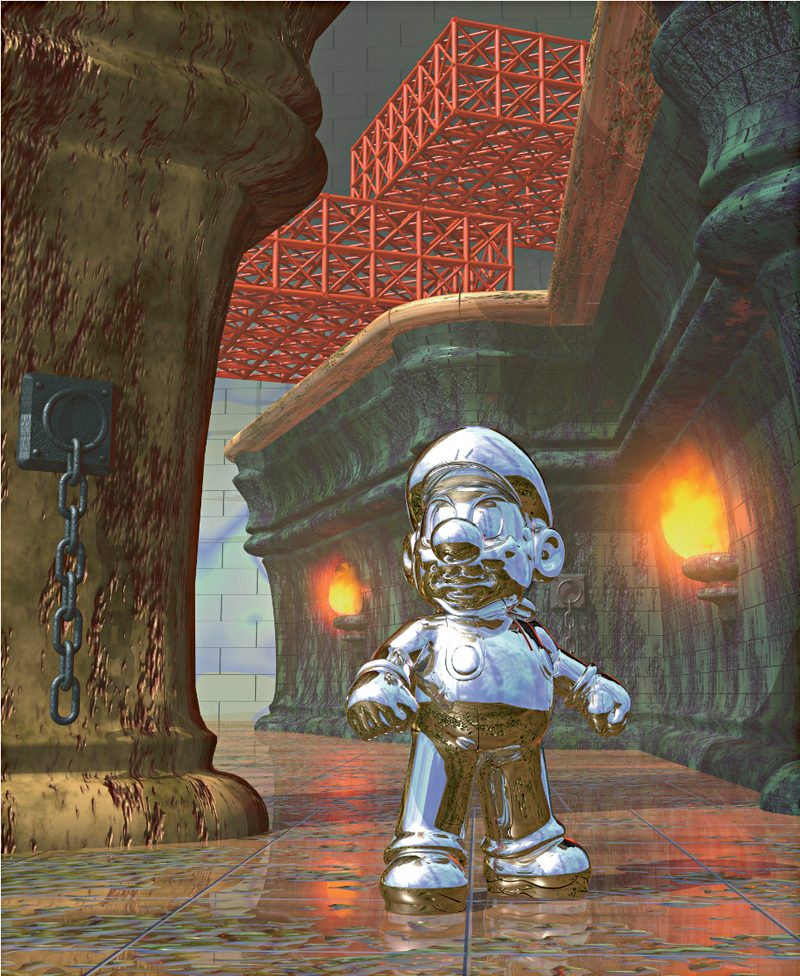 |
It's your one way ticket to midnightCall it: Heavy MetalHigher than high, feelin' just rightCall it: Heavy MetalDesperation on a red lineCall it: Heavy Metal, noise... |
Playthrough
Played On: Nintendo Switch, via Super Mario 3D All-Stars
I've always had a fondness for this game's music. The new arrangement of the Super Mario Bros. Ground Theme on the title screen is awesome, and even the file select screen has a nice little tune.
There it is, the first use of the name “Peach” in a mainline Super Mario game, in her letter!
The Lakitu Bros. recording Mario's adventure is a clever way to work the game's camera system into the story, and actually explains why the camera can't go certain areas.
Beginning with Mario in an open space in front of the castle is a really good move on the developers' part, allowing players to freely experiment with moving Mario around, not having to worry about obstacles, precision platforming, or enemies.
On this playthrough, I spent a minute or two just running around outside, seeing how well my muscle memory holds up.
Why are the Toads translucent before you talk to them? Is it just so they don't stick out against the background, or because they're not actually there, and it's their way of projecting an image to talk to Mario because they're trapped inside the castle walls?
Course 1: Bob-Omb Battlefield
Really good level to start things out with. A nice mix of everything, aside from bottomless pits, encouraging experimentation with platforming, and the wide-open area comprising the Course emphasizes the game's non-linear, explatory nature, especially compared to the previous Super Mario games.
Interesting theme, set during a war between the usual black enemy Bob-Ombs and the pink, friendly, Bob-Omb Buddies.
I was mistaken about what to do when I first fought the Big Bob-Omb as a kid, and threw him off the mountain entirely. We probably all did that, right?
In the Nintendo DS remake, the Big Bob-Omb is fixated on mustaches, and the boss battle itself is very different if playing as Yoshi.
Koopa the Quick will disqualify Mario for cheating via cannon or flight...but he runs up a slope that Mario can't. Seems kinda hypocritical.
Course 2: Whomp's Fortress
Always felt bad about sneaking up on and attacking the sleeping Piranha Plants.
This Course is smaller than Bob-Omb Battlefield, and also features a mission involving a boss battle at the very top. However, it's a bit more difficult, with a lot more floating platforms and the ability to fall off the Course into the abyss.
The Whomp King has some fun dialogue, fighting on behalf of all stones in the world, especially when he confuses “grovel” for “gravel”.
Bullet Bills make their 3D debut here, and can NOT be defeated by jumping on them, like in previous games. Learned that the hard way.
Thwomps in this game were redesigned to be more square, blue, and have their spikes removed. Kinda weird.
This design for Thwomps later appeared in Super Smash Bros. Melee and Super Smash Bros. Brawl, as one of the random things Kirby can transform into when using his “Stone” attack.
But the DS remake reverted them back to their usual design.
Hoot the owl is cool. He'll carry Mario in his talons and drop him off anywhere on the fortress (depending on the player's aim). But if you hold on too long, he'll make a crack about Mario's weight and drop him (not as cool).
The official Super Mario Twitter account for Ireland and the UK used to have their location listed as “Whomp's Fortress”.
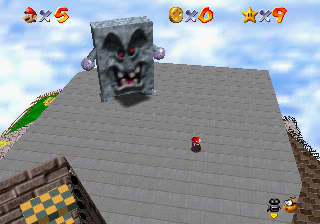
You blockhead.
Course 3: Jolly Roger Bay
The painting leading to this Course originally depicted some underwater bubbles in Japan, as well as in all versions of the DS remake. The painting in the international versions instead depict the sunken ship. The 1997 Japan-exclusive Rumble Pak version has the latter painting, and thus the version I played on 3D All-Stars does, too.
Unagi the eel is kinda terrifying.
“Unagi”, by the way, is the Japanese word for freshwater eel. That might be why it was renamed to “Maw-Ray”, since “Unagi” is a bit too on the nose.
The first Power Star, “Plunder in the Sunken Ship” isn't very well designed, since the player is given no hints about what order to unlock the chests, and getting it wrong leads to Mario taking damage. It's pretty much based on luck if you don't already know.
The DS remake fixes this by removing the puzzle and replacing it with a single treasure chest.
The ship surfacing with Mario inside it is cool, though, as the water drains from it.
Course 4: Cool, Cool Mountain
I admit, it wasn't until 3D All-Stars that I realized that the music for the snow levels is a rearrangement of the Super Mario 64 Main Theme heard previously in Bob-Omb Battlefield and Whomp's Fortress (and two later Courses)
There's some debate at the name of the baby penguin that got separated from her mother. The mission name “L'il Penguin Lost” and a tweet from Nintendo of America suggest that it's “L'il Penguin”. The Official Player's Guide states that it's “Tuxie”, which is what I've always called her.
When Mario does a dive near Tuxie/L'il Penguin, she'll imitate him and do one, too. That's cute.
I always found it funny that there's an impostor penguin near the mother.
I never toss Tuxie over the edge like most people seem to (I really love penguins), but I admit that I do pick her up and run away, causing the Mother Penguin to angrily chase Mario for a bit, before I give Tuxie back to her mom and collect the Star.
The opponent in “Big Penguin Race” felt unbeatable when I first played the game. And I feel like I should mention that after all 120 Stars are collected, the penguin is now quite a bit larger due to being, as he puts it, “out of shape”, making the race more difficult.
The game has an internal timer for this mission, for every time Mario goes airborne. If it's more than two seconds (say, due to intentionally falling off the slide to reach the bottom quicker), the penguin will accuse Mario of cheating and not give him the Star.
Me completing the mission for “Snowman's Lost His Head” was kinda funny to watch, since I had to try it three times, and all three times Mario got run over by the rolling snowball I was trying to deliver to the Snowman's head. Luckily, the last one rolled over me right in front of the platform where the head was, so I completed it. Felt very Looney Tunes.
I got so good at “The Princess' Secret Slide” that I was able to summon the secret Star while trying to get the regular one.
Bowser in the Dark World
These Bowser levels were always among my favorites, due to the more linear layout and the default camera view being on the side invoking the 2D Super Mario games. There's not much of any side missions, aside from collecting 8 Red Coins, which is optional. It's mostly just a straight-up platforming gauntlet.
The music for the Bowser levels is just magnificent. Love this track.
The Bowser battles are probably the most iconic moment of this game. Mario swinging Bowser around by the tail to throw him at bombs? That's pretty rad, and a good use of the N64's analog stick. Sure, it would've been possible to rotate a D-pad like that (and you can in the DS remake, in fact), but the analog stick works SO much better.
Seeing the Warp Pipe in this level as a kid was so cool. In a weird way, it was a connection to the 2D games I knew and love, reminding me that this is, in fact, a legit Super Mario game.
Ten Power Stars have been collected, now! Time to look up at the castle ceiling, get teleported to the Tower of the Wing Cap, and hit the switch to activate the Red ! Blocks.
My brothers and I each had our favorite power-up in this game, corresponding to our favorite color.
The middle child's favorite color is green, so his favorite was the Metal Cap. The youngest preferred blue, so he liked the Vanish Cap. The oldest (me) has always liked red, and thus I gravitated towards the Wing Cap.
In hindsight, though...I think the Metal Cap is definitely the coolest (explaining why it's the only one that made appearances after this game), but the Wing Cap is still my favorite. It's the most tied to this game in particular (being on the box art, the first one that the player can unlock, and the only Cap Power that Mario can use in the DS remake), and there's something magical about being able to (mostly) freely fly around in a 3D space, with that majestic cover of the Super Mario invincibility theme.
Course 5: Big Boo's Haunt
After getting eight Stars and clearing “Bowser in the Dark World”, Mario can explore the castle's basement and go to Courses 6, 7, and 8. But not 5, because the Boos don't appear in the castle courtyard until the player has 12 Stars.
It's pretty neat how the game is already moving away from the conventions it established on the first floor. Instead of jumping into paintings, Mario gets into Course 5 by defeating a Boo in the courtyard that's holding a small carousel (or a birdcage?), then jumping into the carousel, shrinking as he does so.
Honestly, I think the ghost houses in previous, 2D Super Marios weren't particularly creepy. Just a lighthearted spookiness, like in Scooby-Doo or something.
“Big Boo's Haunt”, though...kinda legitimately creepy. There's that unnerving music playing throughout (aside from the carousel, which is just as creepy, if not more so), the jumpscare of the Mad Piano, the dark atmosphere and lighting, the threatening messages that appear upon defeating a Boo, the large open spaces devoid of any living characters...it's pretty effective light horror for a game rated K-A.
That said, there's some cute moments of levity, like the sign outside saying that Mario deserves a “Ghoul Medal” if he survives, or the narrator introducing the Big Boo almost like an old-school wrestler (even funnier if it's the Big Boo introducing himself, though it's unclear).
“Secret of the Haunted Books” is a puzzle similar to “Plunder in the Sunken Ship”, that punishes the player for getting the order wrong. But there's only two wrong answers and no time limit, so it's better.
Though timing Mario's jumps correctly can lead to the player bypassing the puzzle completely.
On my last playthrough, the 100-Coin Star got away from me after I collected it.
Course 6: Hazy Maze Cave
There's the classic Super Mario Bros. Underground Theme!
Hazy Maze Cave seems to be the most-realized of the areas we've seen in the game so far. There's a bunch of man-made structures and a “work elevator”, indicating that some kind of employment goes on. My guess was always mining.
Dorrie is interesting. The sign near the lake claims that he can eat Mario, but he's perfectly harmless and is even necessary to reach the Star.
As a kid, I always assumed the sign was written by someone superstitious who fears Dorrie for no reason.
Dorrie is also strangely adorable despite how ugly his 3D model is. Must be the eyes.
Never liked how Mario has to ground-pound Dorrie's back to make him lower his head, especially because he gives an audible cry of pain when you do.
The Cavern of the Metal Cap is where the Green Cap Switch is located, and the arena where Metal Mario is battled in the original Super Smash Bros. seems to be mostly based on this area.
The texture on Metal Mario is a photo of a garden. The pink spots are flower petals.
Again, Metal Mario is really cool. I own a plushie of him, too. The fact that one of the Stars in this course calls him “Metal-Head Mario” makes him sound even more awesome.
Course 7: Lethal Lava Land
The only Course accessed through a painting in the castle's basement.
To me, the painting always looked like one of the fireballs Bowser drops in Super Mario World, but the Japanese name of the Course suggests that it's supposed to represent a Lava Bubble.
...why is there a painting hanging in the basement, anyway?
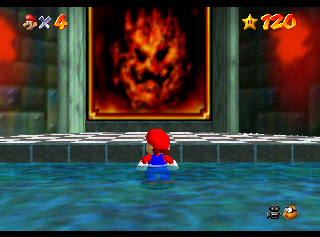
Maybe they found it too creepy to keep in one of the above-ground rooms...
I really dig the 60s psychedelic rock track that plays for both this Course and the next one.
Bullies are just as irritating as their namesake, with their constant charging at Mario, and our hero's getting up animation being long enough to just barely dodge them...sometimes.
The name “Bully” is kinda clever, though, since they push Mario around and have bovine-like horns.
The image of Bowser used in the shifting Red Coin puzzle is originally from The Lost Levels, then later reused in Super Mario Bros. 3 and Super Mario World.
I'm not the biggest fan of the inside of the volcano, so I only went in there once in this playthrough.
Is the volcano supposed to be at least somewhat mechanical? The platform around it stops spinning so it can erupt on a set schedule, and there's a steel...thing that pops out of the wall inside to crush Mario.
For some unknown reason (maybe it's the shade of red or the texture), the lava inside the volcano always reminds me of pizza sauce.
Course 8: Shifting Sand Land
No painting here. You gotta jump into the wall itself!
This course's name might be a reference to one of the desert quadrants from Frank L. Baum's Oz books, the “Shifting Sands”.
It might also be a reference to the quicksand making up most of the level.
Or both!
It's funny how desert levels in Super Mario games seem like a requirement now, but this is the first one we've gotten since SMB3.
All the quicksand (of varying consistency) makes traveling through the level tricky.
I didn't even bother with the Tox Box maze on this playthrough.
The character of Klepto the Condor is pretty memorable. Partly because he holds a Power Star in one mission, and can steal Mario's cap in the rest of them.
In fact, in my last playthrough, I went to the oasis palm tree to warp, and that bird flew past as Mario was vanishing in order to take the cap! It was so funny I wasn't even mad.
The inside of the pyramid is interesting, but rather frustrating...unless you enter from the top after standing on all four pillars and defeat the Eyerock boss, which is pretty cool.
Course 9: Dire, Dire Docks
This Course is blocking the way to the next Bowser level. Let's fix that.
It's a repeat of the water theme from Jolly Roger Bay, but the layout is different enough to justify it: instead of starting on the beach, Mario starts by landing in the water and has to swim down very far to reach an underwater cave which opens back up at the titular docks.
According to the Player's Guide, the docks are preparing to launch Bowser's sub so he can terrorize the seas of the Mushroom Kingdom!
So, as the titular Super Mario, your job is to, uh...collect the Power Star on top of the submarine. That apparently is enough to stop it.
The image of Bowser on the sub is from art for the original Super Mario Bros.
This is the only place in the game where the player can combine Cap powers. It's recommended (but not required) to collect the Metal and Vanish Caps for the “Collect the Caps...” Star. Too bad there's not a Wing Cap around as well, so you can have a Metal Vanish Wing Mario (I do remember drawing that once as a kid, though).
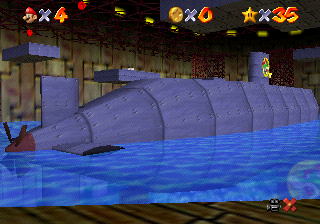
We're all stopping a Bowser submarine
A Bowser submarine
A Bowser submarine
The narrator asking me “how's it going, otherwise?” after collecting 30 Stars is very nice. I appreciate that.
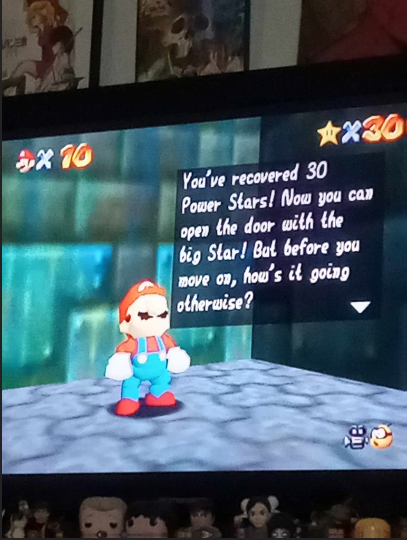
Not bad, thanks for asking! Bowser in the Fire Sea
Another repeated theme! Lava and fire, just like Course 7. Probably why it's my least favorite of the Bowser levels.
At one point, the platforms start rising and falling in an accordion-like folding motion, which is...something.
For reasons I can't understand, as a kid, the cage in the level reminded me of a McDonald's restaurant. Not fast food in general, McDonald's specifically.
What exactly is the entrance to the Bowser battle here? Some kind of mystical (but still solid) portal? It looks neat, but I don't know what it is.
For this rematch, Bowser's got some new moves: he can stomp on the battlefield, tilting it sharply, he can breathe fireballs instead of a steady stream, he can teleport behind Mario, and (the most useful one) he can charge towards Mario if our hero is far enough away.
It's the most useful because the player can stand close to the edge of the platform, and then dodge Bowser as he charges forward, leaving him teetering on the edge, and giving the player access to grab his tail.
I didn't mention this last time, but I've always liked the animation of Mario grabbing a key, with the nifty camerawork and rapid cuts.
MIPS the rabbit shows up twice in the castle's basement, once at 15 Stars, and once at 50. He's very fast and I spent a lot of time trying to catch the little guy.
When caught, MIPS references the White Rabbit from Alice's Adventures in Wonderland. A fitting reference, considering how much Super Mario owes to that book.
I had a friend in elementary school who claimed to have 119 Stars in the game, and we managed to figure out that the one he didn't have was from the second encounter with MIPS. Because if you don't catch him when you have exactly 50 Stars, you won't see him again (or maybe he just said that so I'd shut up about it).
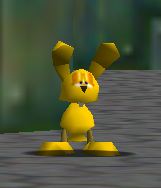
Kinda cute in a dopey sorta way, isn't he?
Onwards to the second floor of the castle!
Course 10: Snowman's Land
I love the way the player discovers the location of this course: go into the room with the huge mirror on the wall (and get reminded that you're seeing the whole game through a Lakitu's camera, since he shows up in the reflection), and notice that the painting for Cool, Cool Mountain is on the wall in the mirror's reflection, but not in the actual room. The player then has to jump into that blank wall. Really clever.
Wasn't until well into my adulthood that I realized that this course's name is a pun on the phrase “no man's land”.
It's a reuse of the snow level theme from Cool, Cool Mountain. It's a smaller level, with the only things to note are the giant snowman with a Star on his head, and the igloo Mario can explore.
My biggest takeaway from this course is that the giant snowman can blow Mario's hat off his head, and that there's a way to use glitches to have Mario holding his hat in his hand for the whole level, or to give him two hats: one on his head, one in his hand.
Course 11: Wet-Dry World
The gimmick for this one is that the water level is relative to where Mario jumps into the painting (the closer to the top he goes in, the higher the water level is)
This course is massive, “uptown” being a big open area, that seems to have some construction work going on and encourages exploration and solving puzzles by changing the water level.
After some cannon fire and some swimming (or just swimming if the water level is high enough), Mario can explore “downtown”, which is seems to be an abandoned town square. Pretty cool.
Always found downtown to be more interesting, visually, so, as a kid I'd always head straight there, not getting very many of the uptown Power Stars.
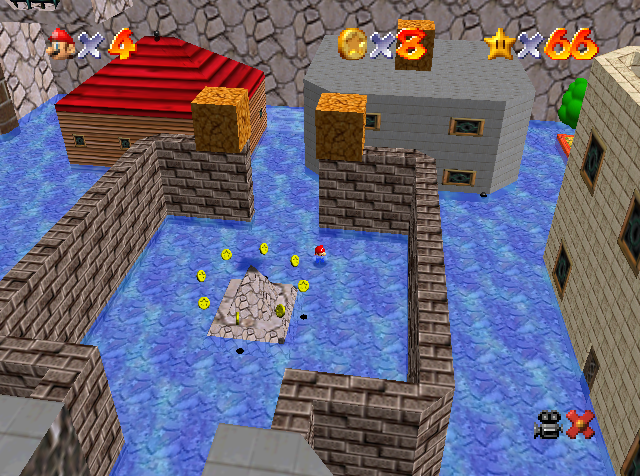
So go downtownThings will be great when you'reDowntownNo finer place for sureDowntownEverything's waiting for you
(lotta musical references in these captions, sorry)
Course 12: Tall, Tall Mountain
It's a very tall mountain, with a Power Star at the top, and some classic mushroom platforms.
- I guess it is kinda funny that the smallest painting in the whole game leads to a massive mountain.
- I guess it is kinda funny that the smallest painting in the whole game leads to a massive mountain.
The only things really of note are the Ukkiki monkeys, one of which tries to steal Mario's cap, and the other needs to be caught to unlock a Star, and the slide hidden in the side of the mountain.
This slide has a unique background, with smiling stars and moons, and a dead end marked with a large skull painted onto the wall.
I guess there's not a whole lot to it, but I've always had a fondness for this one.
Course 13: Tiny-Huge Island
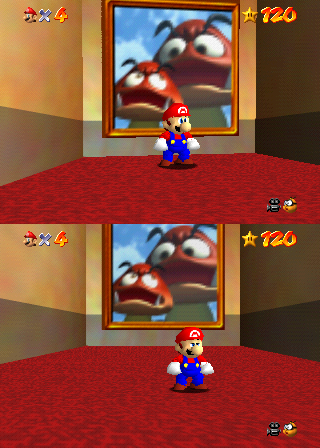
One pic makes you larger
And one pic makes you small
And the ones that mother gives you
Don't do anything at all
Go ask Alice
When she's ten feet tallAnother really cool gimmick. Depending on the painting Mario jumps into, either the island and enemies will be gigantic (a la World 4 from Super Mario Bros. 3), or Mario will be gigantic, and everything else will be small.
Only one Star actually requires Mario to be giant, unfortunately, which means that the gimmick isn't explored as much as I'd like.
I like the idea of changing Mario's size inside the level by jumping into a Warp Pipe, especially since doing so plays a new version of the classic power-up/power-down sound effect from the 2D Super Marios.
Koopa the Quick makes his return here, saying that Tiny-Huge Island is his home course (explaining his size, possibly) and challenging Mario to a rematch.
Also, if Mario is giant, there's a tiny Koopa Troopa standing where Koopa the Quick does when Mario is small. This Troopa can be defeated for a Blue Coin...I'm pretty sure that's actually Koopa the Quick.
Punching a tiny Goomba while as giant Mario is hilarious. That thing goes rocketing off the screen. My brothers and I joked that Mario knocked them into orbit.
One of the Stars that requires Mario to be both sizes is “Make Wiggler Squirm”, where giant Mario has to drain the lake at the top of the mountain, then become tiny to enter the mountain and discover the very angry Wiggler that lives inside.
Honestly, I'm gonna take the Wiggler's side here. If someone suddenly flooded my home and then jumped on my head, I'd be pretty upset, too.
That said, Wiggler calms down a lot after handing the Power Star over to Mario.
Fifty Stars in, and I can now unlock the top floor of Princess Peach's Castle, giving me access to the final two Courses.
There's another large Star Door here, one that'll lead to the final showdown with Bowser...if I have at least 70 Stars. The door still opens, but it leads to the “endless stairs”: a staircase that keeps going up infinitely as a Shepard scale plays.
Course 14: Tick Tock Clock
There's a cool gimmick with this one. The position of the minute hand on the clock face when Mario jumps into it determines the speed of the mechanical parts of the course. Jumping in when it's at 12 makes everything stop, 3 makes it all slow, 6 has it moving randomly, and 9 puts it all at a fast speed.
That said, despite the gimmick, it's a pretty bland Course. Most of the Stars are just “go a little higher up from where you found the last one”. Kind of a case of missed potential.
There's not much else to it.
Well, aside from the Star named “The Pit and the Pendulums”, which is an amusing reference.
Course 15: Rainbow Ride
On the opposite side of the room containing the entrance to Rainbow Ride is a bonus area titled “Wing Mario Over the Rainbow”, which is a Red Coin-collection area.
A level in the Super Smash Bros. series, named “Rainbow Cruise” (after this Course's Japanese name) starts appearing starting with the second game.
You're in the sky now! Jump on flying carpets that ride on rails that look like rainbows. There's a house up here, and a wooden ship with wings.
I really dislike this Course. The platforming is imprecise because of things getting in the way of the camera and the magic carpet moving at its own pace, which also makes it very tedious, turning my favorite Steppenwolf song into a “Tragic Carpet Ride”. I probably lost close to a dozen lives just trying to get two of the Stars.
Bowser in the Sky
Final Bowser level! This one feels like a final exam about everything you've encountered in the game. There's rotating platforms, a Whomp, a Chuckya, flamethrowers, Goombas, Amps, strong winds, a tiny Piranha Plant (from Course 13), seesaws, poles to climb and jump from...
And while it's been a recurring theme for all these Bowser levels, this one seems to be especially playing up the fact that Mario is ascending higher and higher into the sky as he progresses, even including high winds near the very top.
Speaking of the high winds at the top, there's a bunch of stone pillars Mario can hide behind to block the wind, and those pillars have engravings of Mario jumping over Bowser's flame breath on them. Very cool touch.
Time for the final battle! Let's-a go!
First thing to note is that the music is different. Instead of it being Bowser's usual rock theme, it's a slower, more dramatic organ piece that I think sounds absolutely epic, and gives a lot more weight to this battle. Great stuff.
Bowser himself is oddly rainbow-colored this time, which I guess is due to the lighting reflecting onto him? It doesn't affect Mario's coloration, though, and maybe that's why it was changed for the DS remake to put Bowser back to his normal colors.
Aside from the same moves he had last time, Bowser can now breathe fire into the air above him (causing Lava Bubbles to bounce around when the flames hit the floor), and instead of tilting the battlefield over with a stomp, his landing on the ground sends electrifying shock waves through the floor.
The tactic of waiting on the edge for Bowser to charge at Mario is still valid, even though you probably gotta wait for him to do a few of those shockwave stomps first.
This time, though, throwing Bowser at one bomb isn't enough. After the second one, Bowser angrily stomps on the battlefield, breaking it apart until it's the shape of a star, which not only makes the aiming more difficult, but is thematically appropriate to the game as a whole.
If the player launches Bowser off the platform without him hitting a bomb, Bowser may cause parts of the arena to break off upon returning from the abyss.
Bowser is defeated, and leaves behind the “Jumbo Star”. Mario collects it, giving him a Wing Cap, and allowing him to fly away.
Mario lands in front of the castle, where Princess Peach is freed from the stained glass window where she's being held. She thanks Mario for returning the power of the Stars to the castle and freeing everyone, then kisses him on the nose (that's cute).
She leads the Toads back into the castle to bake a cake for Mario, and our hero looks up at the camera (and, by extension, the player) before being called inside.
We get a lovely tune over the credits, followed by Mario, Princess Peach, and some Toads waving goodbye, before seeing the cake itself and Mario saying “Thank you so much-a for to playing my game!”
You're welcome, buddy.
Items
Returning:
Coins
Yellow, Red, Blue
1-Up Mushroom
! Switches
Koopa Shell
New:
Spinning Heart
Wing Cap
Metal Cap
Vanish Cap
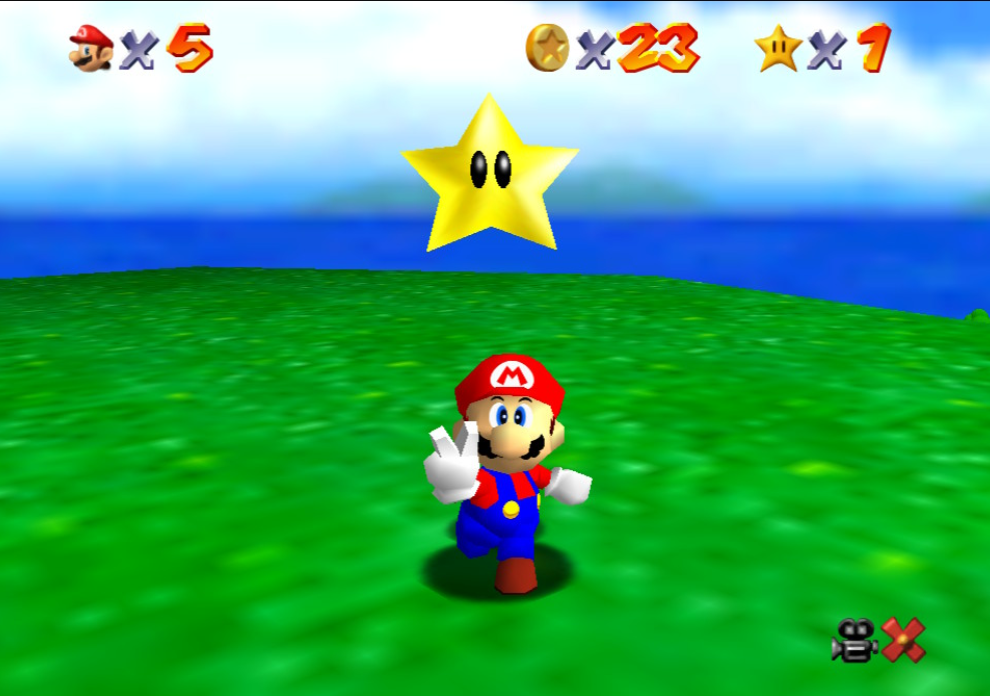 |
| "HERE WE GO!" |
Milestones
First 3D Super Mario platformer.
Debut of the name “Princess Peach” in a mainline Super Mario game outside of Japan.
As I'm sure you've noticed reading these so far, the character had been known as “Princess Toadstool” in the West (aside from Yoshi's Safari in 1993, for some reason, which used the “Princess Peach” name).
Debut of Power Stars
First appearance of Wing Mario and Metal Mario.
Also, Vanish Mario, but I don't think that ever shows up outside of SM64.
Debut appearances of the Big Bob-Omb (later renamed King Bob-Omb), Dorrie, Bullies, Bob-Omb Buddies, Whomps, Amps, Bubbas (later renamed Cheep Chomps), Flamethrowers, Klepto the Condor, Moneybags, Big Fire Piranhas, Skuttlebugs, Skeeters, Sushis, Tox Boxes, and Unagis (later renamed Maw-Rays).
First time Thwomps are depicted as being blue, spikeless, and square.
Also, the last time they appear that way in a mainline Super Mario.
First in-game appearance of Princess Peach's Castle.
Fourth Super Mario game in a row to not have a playable Luigi.
Though they certainly tried to get 'im in there!
The first Nintendo-produced Mario game to have voice acting.
While he'd portrayed the character through MIRT, Gottlieb's pinball table, and some edutainment titles on PC (Mario Teaches Typing and Mario's Game Gallery/Mario's FUNdamentals)...Super Mario 64 marks the first actual Super Mario game to have Charles Martinet as the voice of Mario.
Debut of Mario catchphrases as “Let's-a go!” “It's-a me, Mario!” “Here we go!” “Thank you so much-a for to playing my game!” and “Mamma-mia!”
Also marks the first Super Mario game to give Princess Peach a voice, provided here by Leslie Swan.
Final Super Mario game directed by Shigeru Miyamoto.
Only Super Mario game for Nintendo 64.
First appearance of Mario's Long Jump, Ground Pound, Punch-punch-kick combo, Wall Kick, Sweep Kick, Slide Kick, Side Somersault, and Triple Jump.
First appearance of the backflip, handstand, and Double Jump in a Super Mario game, having previously appeared (albeit in different forms) in the Game Boy remake of Donkey Kong.
Second Super Mario game to feature a life bar, after Super Mario Bros. 2.
First game where it's possible for Mario to go hatless.
Trivia
In addition to voicing Mario, Charles Martinet provided “Comical Laugh: Male” for the General Series 6000 sound effects pack by Sound Ideas. That clip was slowed down and used for the evil laugh of both Bowser and the Boos, making Martinet technically their voice, too.
Luigi's design in his model removed from the game has him taller than Mario (as usual), but with a similar build, including not having a longer neck. Promotional renders of Luigi from this console generation (such as Mario Kart 64 and the first three Mario Party games) feature him with a similar design. Could it be that the models of Luigi used for those renders were made for Super Mario 64? Who knows?
The bright shade of red on Mario in this game is hex #FF0000, which is as red as red can get. The only other game to use this particular color on Mario is Super Mario World, and that's only for Fire Mario.
The water level of Wet-Dry World varies depending on the height that Mario enters the painting from. Every level painting in the game has multiple entrance points like that, but they don't actually do anything.
MIPS the rabbit is named after the MIPS microprocessor used in the Nintendo 64.
In the Bowser levels, Mario will yell “So long-a, Bowser!” when throwing the Koopa King. There was a minor controversy when 3D All-Stars was released, with Mario yelling “Bye-bye!” instead, and players believing that the line was removed from the game.
Thing is, it wasn't. Bowser is known as “Koopa” in Japan, and thus Mario never says the “So long-a, Bowser!” line in the Japanese version of the game, always saying “Bye-bye!” instead. The version of SM64 on 3D All-Stars is an HD upscale of the 1997 Rumble Pak version of the game...which was released only in Japan, hence the line being missing.
The level “Bowser in the Sky” spawns a Goomba outside of the level bounds, and it's defeated instantly.
The sky background for “Wet-Dry World” is an image of the walled city of Shibam, Yemen, edited to look like it's underwater.
I'm typing this article about Charles Martinet's first time playing Mario in the main series of games on August 21, 2023...the same day his retirement from the role was announced. It's a bittersweet feeling, celebrating his first “real” turn in the role on the day he retires.
Conclusion
So, how does Mario's first foray into 3D platforming, a groundbreaking title that holds a lot of nostalgia for so many people, hold up?
Pretty well for the most part.
The game's graphics are the biggest victim to time. So much pointyness and blurry textures and disjointed polygons, even in Mario himself.
That said, there's a pleasant cartoony aesthetic throughout, and the game's art direction does hold up pretty well...even if the hardware is unable to do it justice in a lot of places. Everything's pretty well-animated, too.
The music if fantastic. Some of Koji Kondo's best work in my opinion. I'd even go as far as saying that Super Mario 64 has the strongest compositions of any “classic” Super Mario game.
Under most circumstances, Mario controls like a dream. It's just plain fun to just run around and perform acrobatic feats...even outside of actual levels. I've spent a lot of times over the years outside Peach's Castle triple-jumping and long-jumping and doing side somersaults. No real reason, aside from it's enjoyable.
Martinet's time voicing Mario is off to a great start, showcasing his range and giving Mario an actual personality.
People complain that there's a weird feeling of isolation in this game, and I guess I can see it inside the castle, where there's nobody else present aside from the Toads...but I disagree when it comes to the Courses themselves, which are often full of life, and many of them feel like actual, lived-in places (or formerly lived-in, like Wet-Dry World), with characters like the Big Bob-Omb, Koopa the Quick, Hoot the Owl, Dorrie, Tuxie and her mom, ect.
There's a lot of personality here, with the variety of characters, and the cool set pieces, such as the boss battles, the slides, the Cap Courses, and sublevels like the volcano and pyramid.
The open-ended nature of the game is a big departure for this series, but it's successful, still retaining the platforming gameplay and “feel” of the previous games while doing something somewhat new.
Overall, I'd say that the first two-thirds of the game are where it really shines. The first nine Courses are fun, each with their own unique identity and quirks. The latter third of the game, with the combination of the last six Courses and returning to previous levels to collect more Stars...makes it feel like the game's starting to run out of steam around the time of “Dire, Dire Docks”.
The later levels reuse some themes to diminishing returns, and don't go as far with the gimmicks or layouts as they should.
Most Courses have their most interesting Stars at the start of the list, so “Wall Kicks Will Work” isn't as enticing as “Big Penguin Race”, for example.
And the 100-Coin Stars can become exercises in frustration.
The camera system was a big deal back in 1996, mapping the controls to the C Buttons so the player can change the angle and zoom in/out if needed, since being able to see where you're going is, uh...kinda important in a platformer.
And it works...most of the time. There are, unfortunately, instances of the camera getting stuck and me not being able to see where Mario's going, or with the only angle I can go with making my jumps more difficult.
Most (if not all) of the game's shortcomings can be explained by this being a pioneer in 3D platform gaming, and a lot of stuff still being figured out. Which does date the game, since other titles (including later Super Marios) have fixed these issues.
That said, what's good about this game is great, and what's bad ranges from a bit disappointing to somewhat annoying at worst. Nothing's a real deal-breaker, but it's certainly flawed.
Despite those flaws, it's a pretty great experience, especially for the time. Recommended, with some reservations.
“Noooo! You’ve really beaten me this time, Mario! I can’t stand losing to you! My troops…worthless! They’ve turned over all the Power Stars! What?! There are 120 in all??? Amazing! There were some in the castle that I missed??!! Now I see peace returning to the world… Oooo! I really hate that! I can’t watch--I’m outta here! Just you wait until next time. Until then, keep that Control Stick smokin'! Buwaa ha ha!”
- Bowser, in the ending
Next time: After an epic adventure like this, Homeboy needs a vacation. How does a tropical island getaway sound? Food, sun, beaches, wrongful imprisonment, graffiti cleanup...hm, that doesn't seem right. Let's head to Isle Delfino to find out who framed our hero in Super Mario Sunshine. See you there!
–

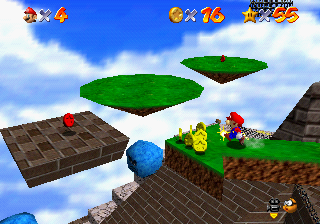
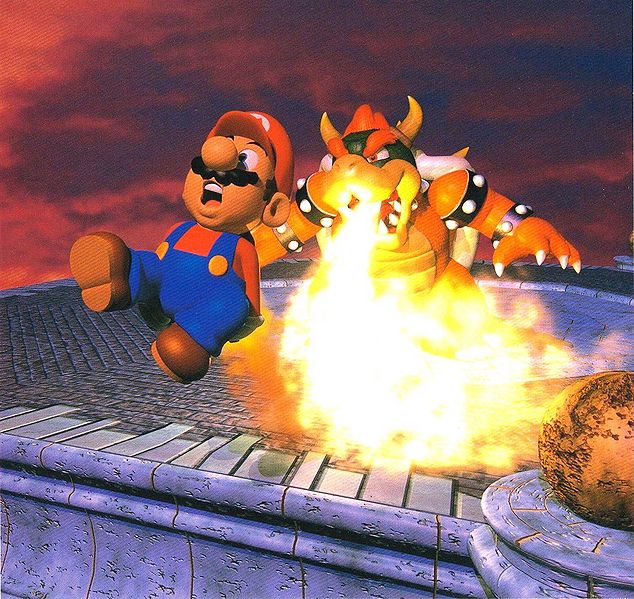
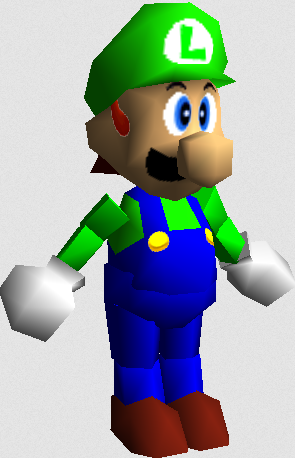
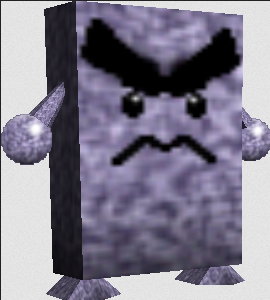
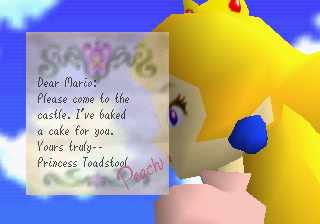
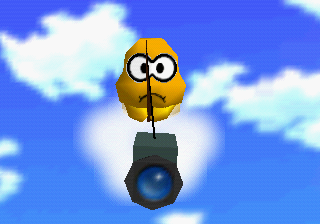
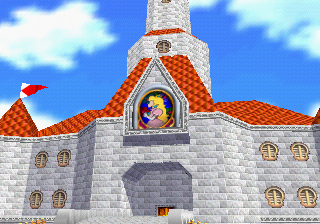
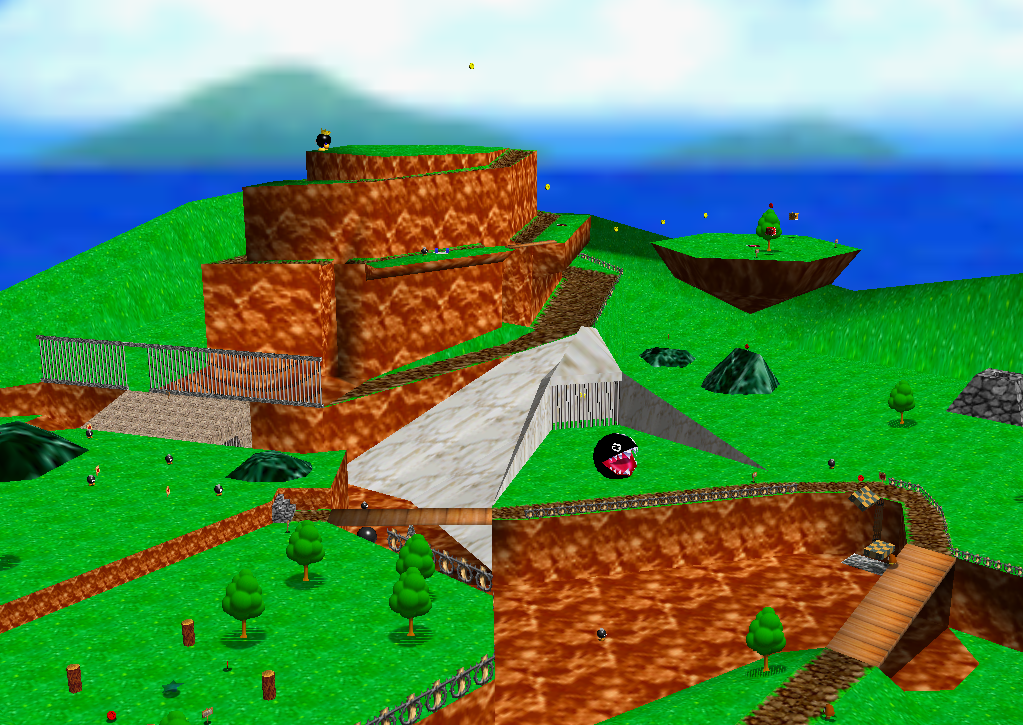
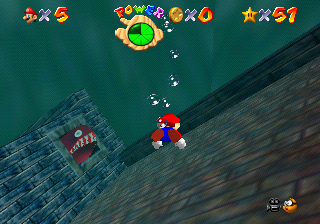
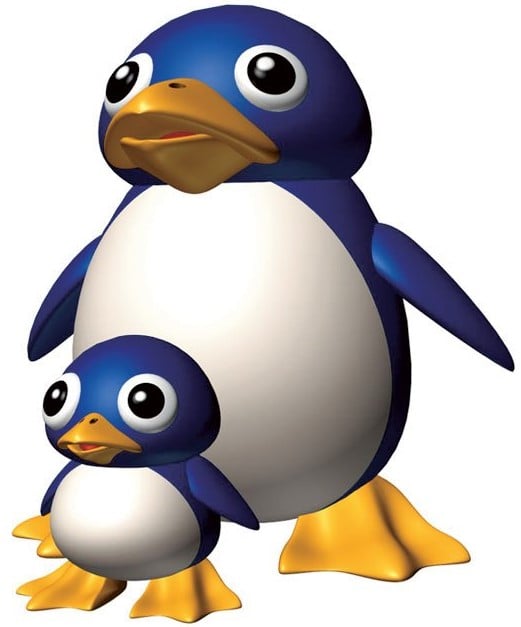
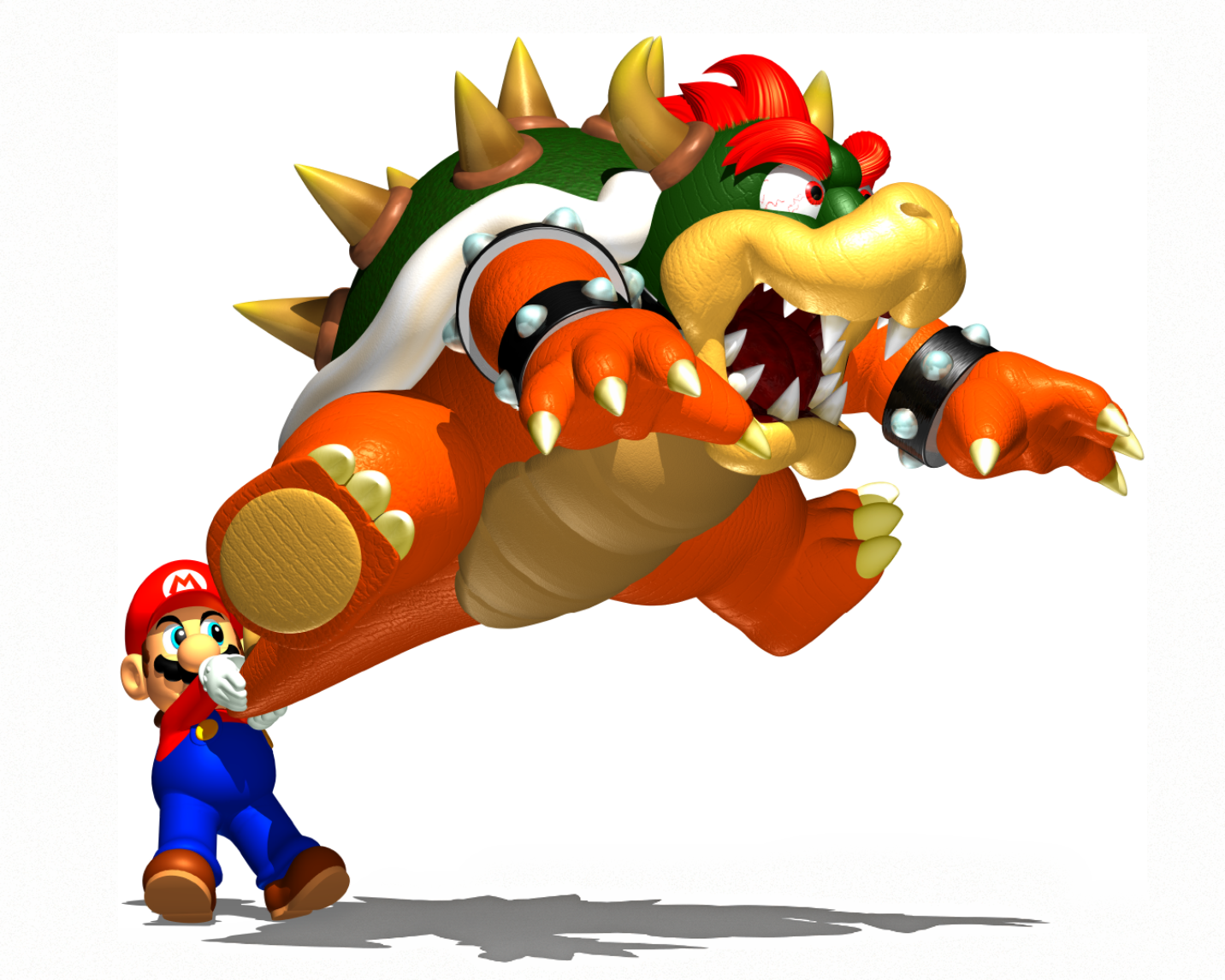
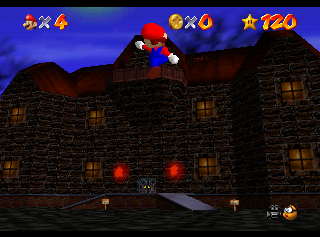
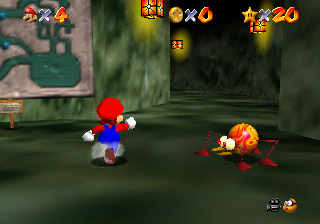
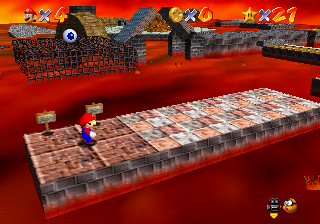
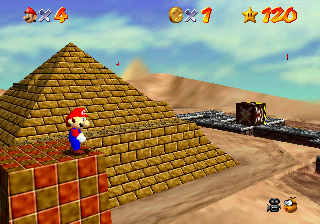

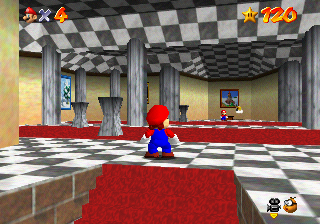
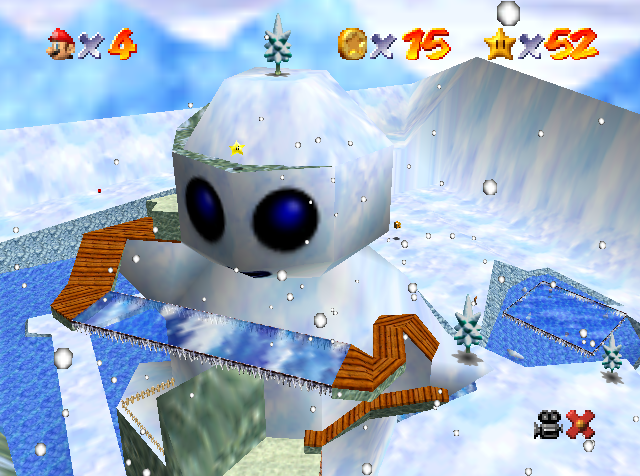
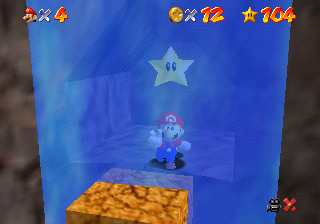
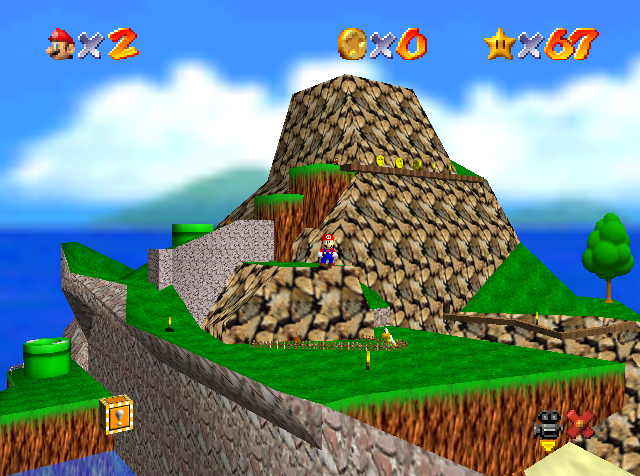
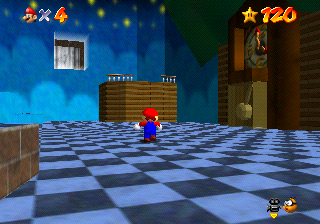
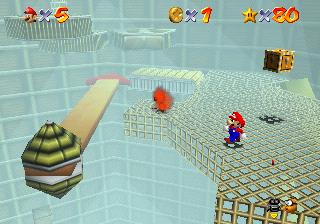
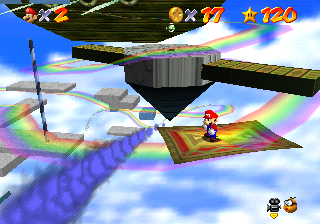
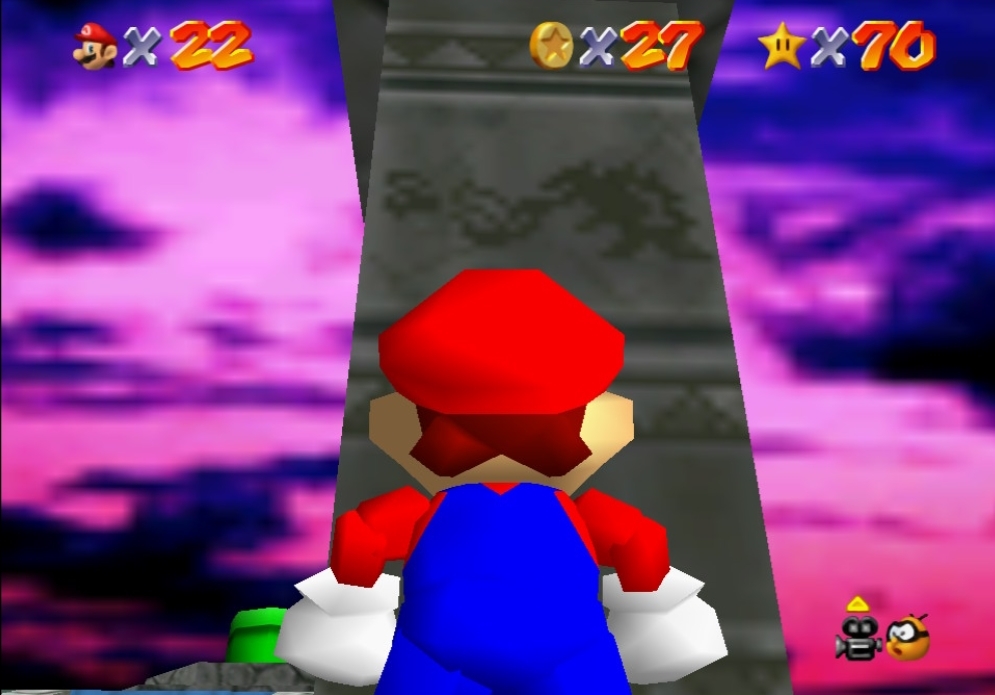
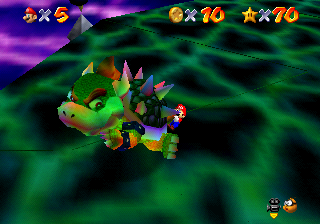
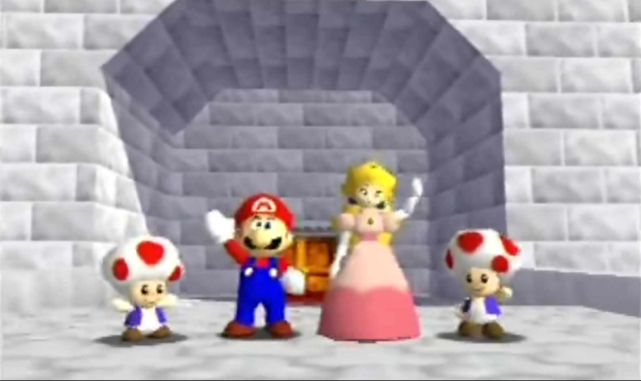
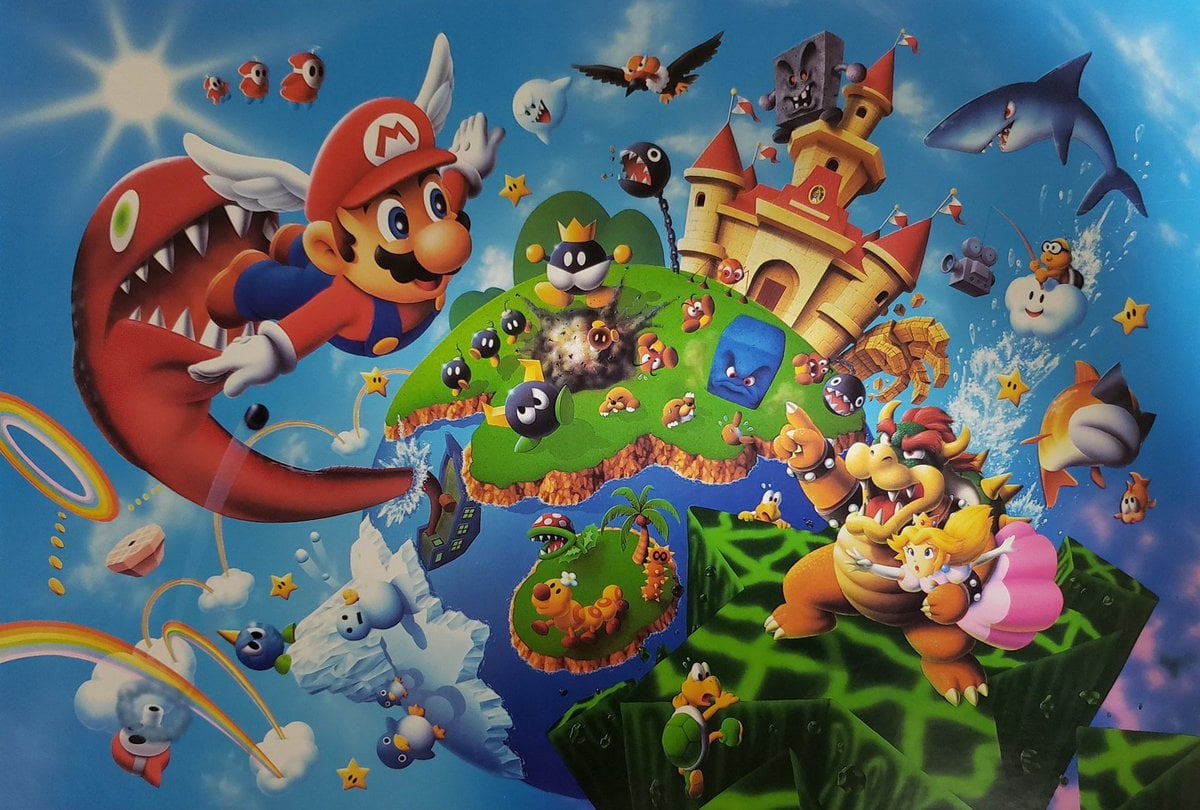
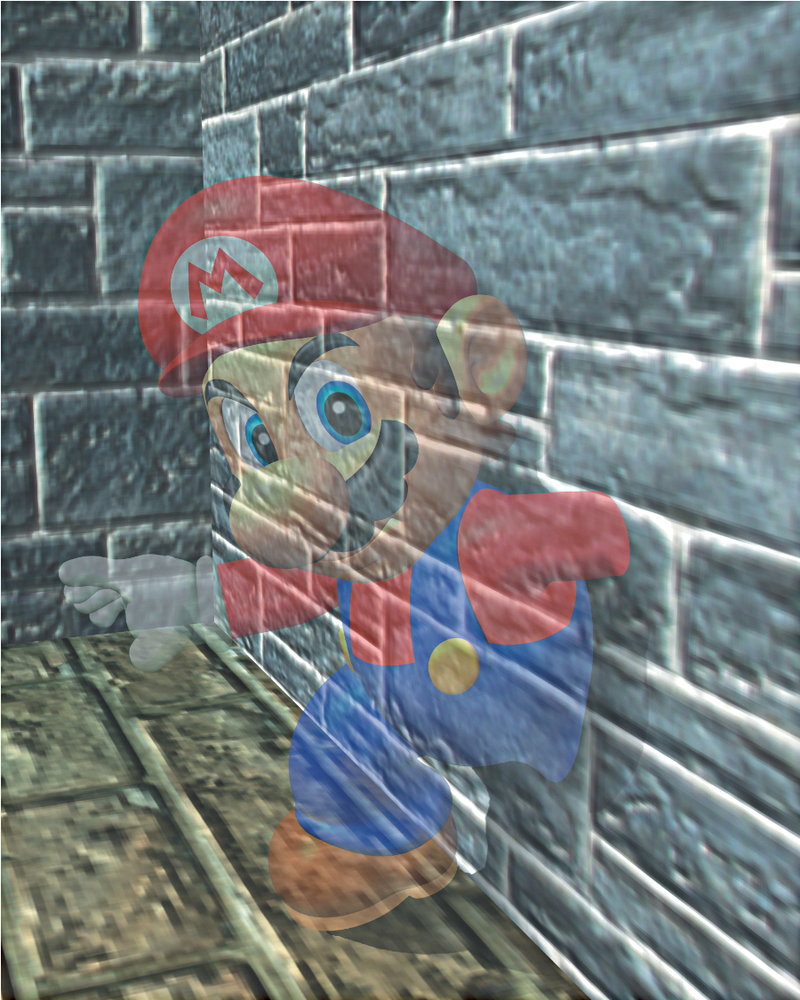
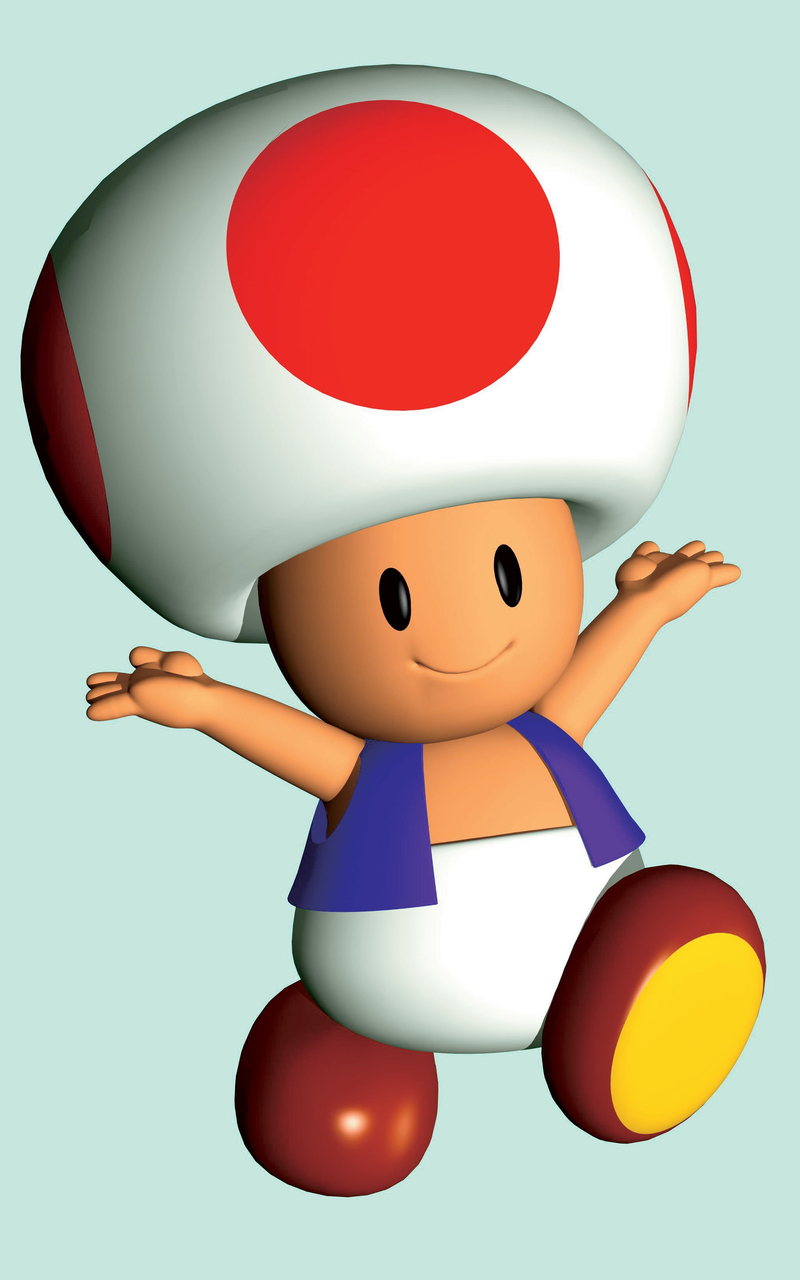
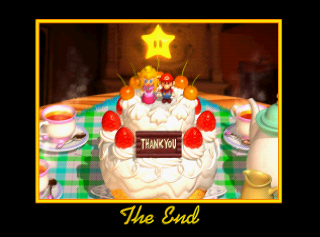
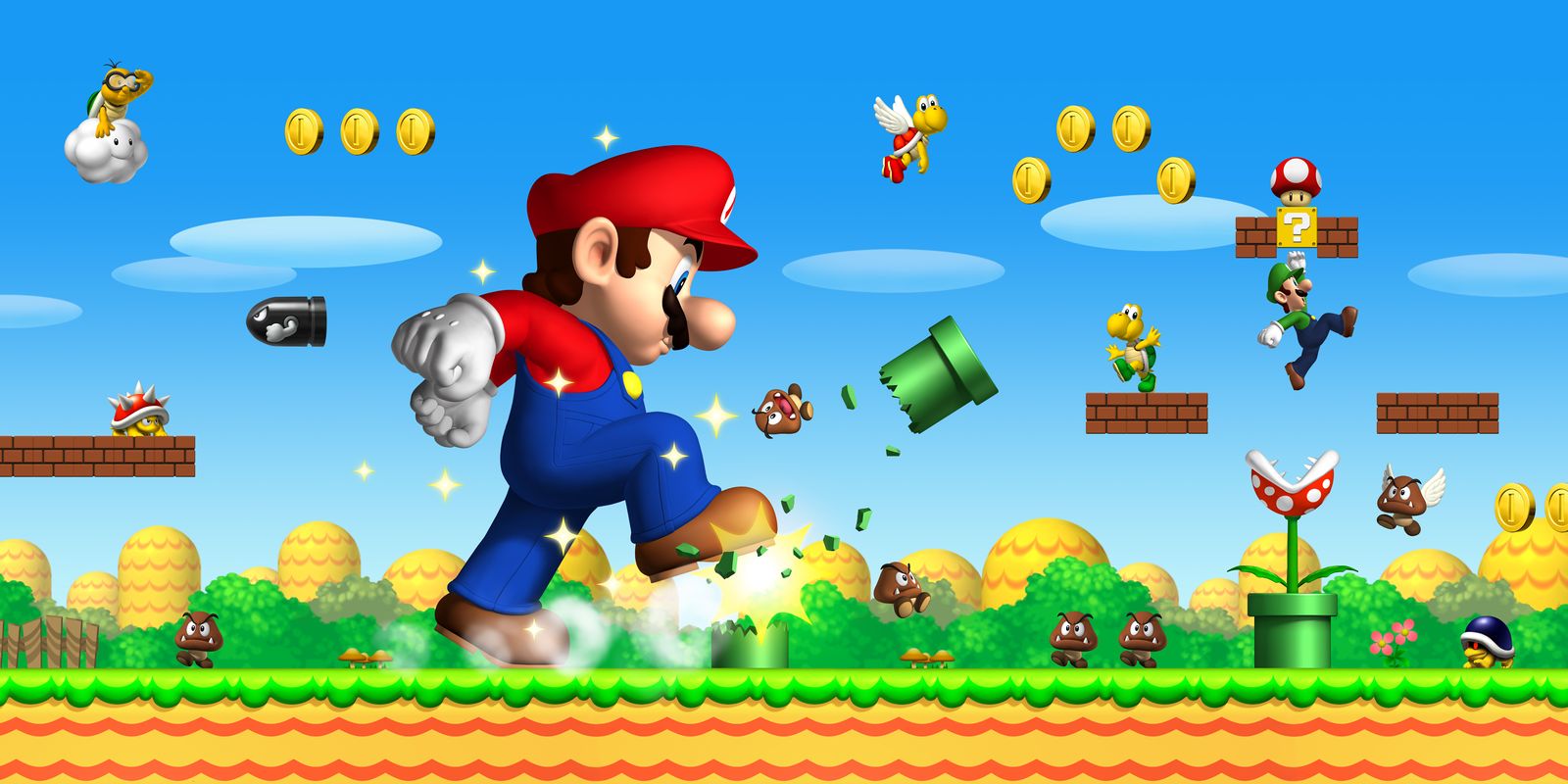

No comments:
Post a Comment